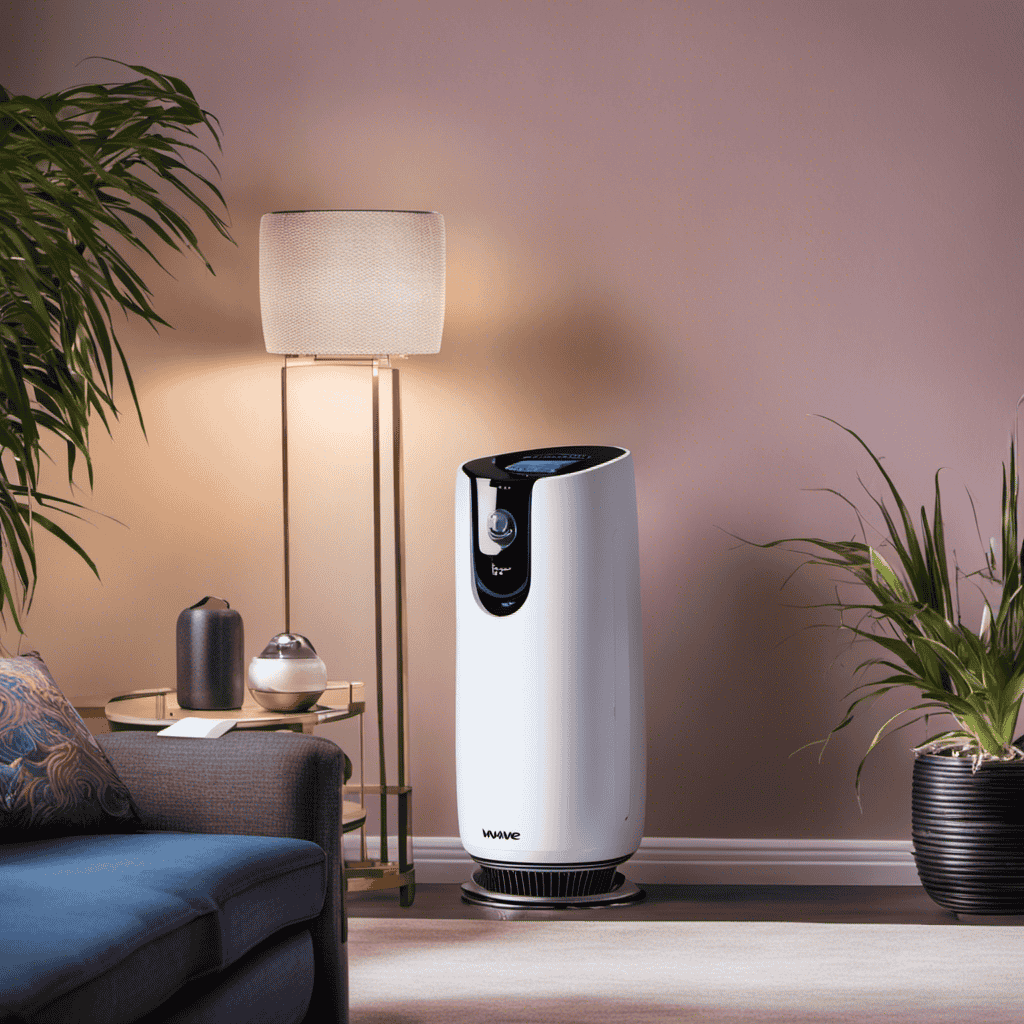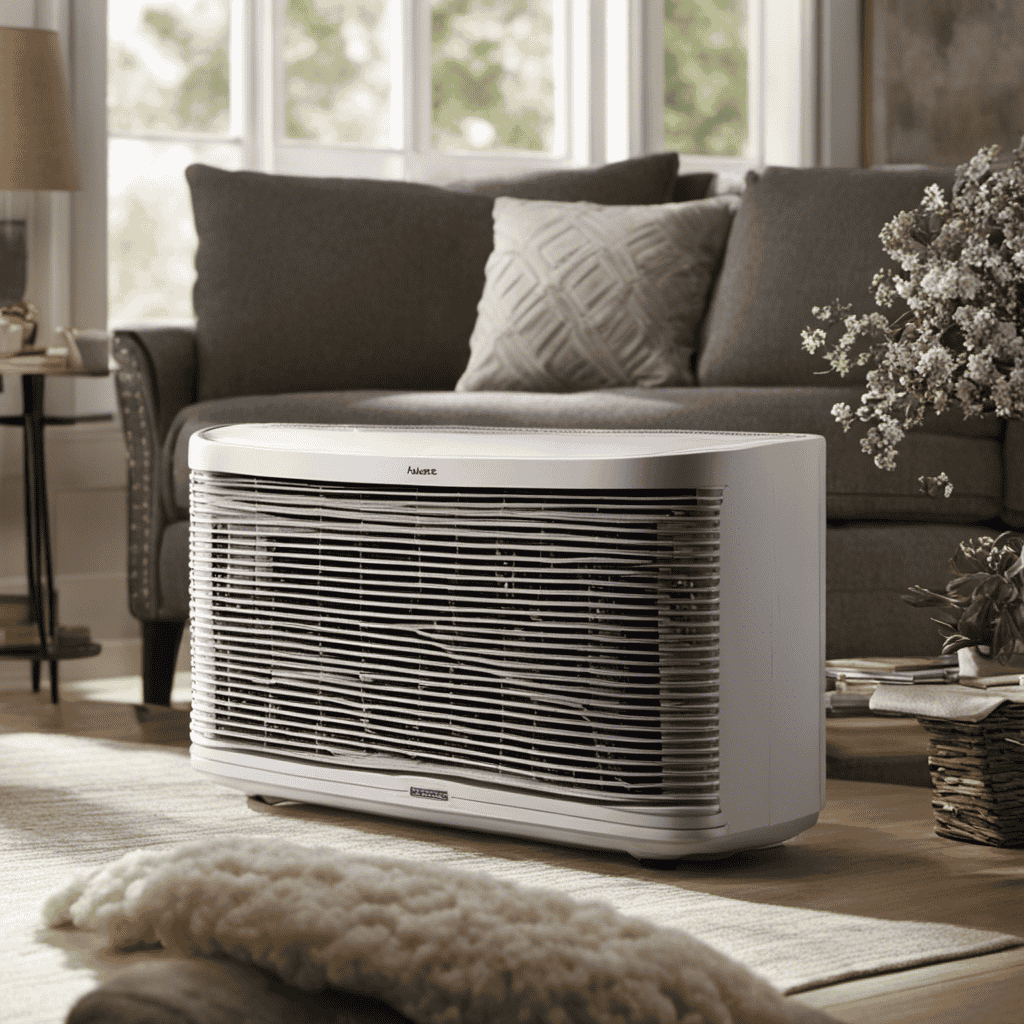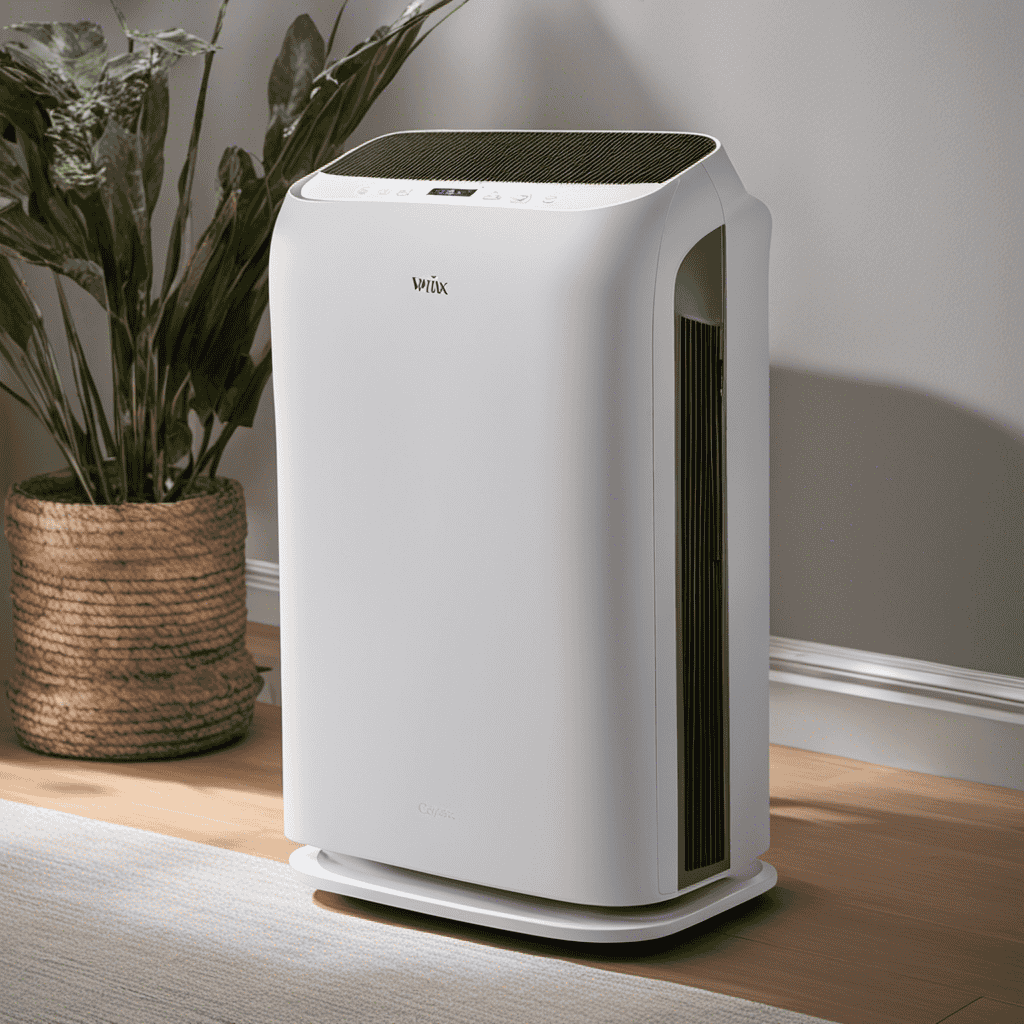Ever pondered on how exactly a plasma air purifier functions? Allow me to explain it to you.
When it comes to improving indoor air quality, plasma air purifiers use advanced technology to effectively remove harmful particles and neutralize odors.
In this article, we will delve into the science behind plasma air purification, explore its benefits, and debunk common myths.
So, if you’re ready to discover the inner workings of this innovative technology, let’s get started!
Key Takeaways
- Plasma air purifiers use electrically charged ions to remove airborne particles.
- The ions attach to the particles in the air, causing them to become charged as well.
- The charged particles are then attracted to oppositely charged electrodes or surfaces within the purifier.
- Plasma air purifiers are highly efficient in capturing and eliminating pollutants, allergens, and odors.
The Science Behind Plasma Air Purification
Plasma air purifiers use electrically charged ions to neutralize and remove airborne particles, such as dust and allergens, from the air. The plasma air purification mechanism relies on the principles of ionization and electrostatic attraction.
When the air passes through the purifier, the electrically charged ions are generated and released into the air. These ions attach to the particles present in the air, causing them to become charged as well. The charged particles are then attracted to the oppositely charged electrodes or surfaces within the purifier.
As a result, the particles are effectively removed from the air, leaving behind cleaner and healthier air to breathe. This process operates continuously, making plasma air purifiers highly efficient in capturing and eliminating various pollutants and allergens present in indoor environments.
Understanding Ionization in Plasma Air Purifiers
When it comes to understanding the ionization process in plasma air purifiers, it is important to grasp the concept of how these devices work.
Ionization is the key mechanism through which plasma air purifiers remove contaminants from the air. By emitting negatively charged ions, plasma air purifiers attract and neutralize positively charged particles, effectively cleansing the air in the process.
The benefits of using plasma air purifiers are numerous, as they not only remove airborne pollutants but also eliminate odors and neutralize harmful bacteria and viruses. In comparison to HEPA filters, plasma air purifiers offer a more efficient and thorough purification process, making them a popular choice for those seeking cleaner and healthier indoor air.
Ionization Process Explained
By emitting negative ions, an air purifier helps to neutralize harmful particles in the air. The ionization process in plasma air purifiers involves the creation of charged particles, called ions, which attach themselves to airborne pollutants, such as dust, allergens, and bacteria. These ions are generated by a corona discharge, which is produced by a high voltage electrical field. The corona discharge causes the molecules in the air to lose or gain electrons, resulting in the formation of positive and negative ions. The negative ions are then released into the air, where they attach to the positively charged particles, causing them to become heavier and fall to the ground or stick to nearby surfaces. This process effectively removes pollutants from the air, improving its quality.
| Ionization Technology | Plasma Air Purification |
|---|---|
| Generates negative ions | Neutralizes harmful particles |
| Uses corona discharge | Improves air quality |
| Attaches to airborne pollutants | Removes pollutants from the air |
| Causes particles to become heavier | Enhances overall indoor environment |
Benefits of Plasma Purification
You can experience cleaner and healthier indoor air by utilizing plasma purification technology. Plasma purification is a cutting-edge air purification method that offers numerous benefits for improving air quality in your home or workspace.
One of the key benefits of clean air is the reduction of airborne pollutants and allergens. Plasma purification technology effectively eliminates harmful particles such as dust, pollen, pet dander, and even viruses and bacteria, resulting in improved air quality.
Breathing cleaner air can have a positive impact on your overall health and well-being, reducing the risk of respiratory illnesses and allergies. Additionally, clean air can enhance concentration, productivity, and sleep quality.
With plasma purification technology, you can create a healthier environment and enjoy the benefits of improved air quality.
Comparing Plasma Vs. HEPA
To compare plasma purification and HEPA filtration, it’s important to consider their effectiveness in removing different types of airborne pollutants. Plasma technology uses high voltage to create ionized particles that attach to airborne pollutants, making them heavy and causing them to fall out of the air. On the other hand, HEPA filtration uses a dense filter to trap particles as small as 0.3 microns. To help you visualize the effectiveness of these methods, here is a comparison table:
| Plasma Purification | HEPA Filtration | |
|---|---|---|
| Smoke | High effectiveness | Moderate effectiveness |
| Pollen | High effectiveness | High effectiveness |
| Dust | High effectiveness | High effectiveness |
| Bacteria | Moderate effectiveness | High effectiveness |
As you can see, plasma purification is highly effective in removing smoke, pollen, and dust, while HEPA filtration is highly effective in removing pollen, dust, and bacteria. Consider your specific needs when choosing between these two technologies.
How Plasma Air Purifiers Remove Harmful Particles
Plasma air purifiers use an ionization process to eliminate harmful particles from the air. The plasma air purification process starts by creating an electrical field that charges the air molecules. This charged air then passes through a series of electrodes, where it encounters numerous ionization chambers.
In these chambers, the charged air molecules collide with airborne particles, such as dust, pollen, and bacteria, causing them to become negatively charged. These negatively charged particles are then attracted to positively charged collector plates within the purifier.
As the air flows through the purifier, these collector plates effectively trap and remove the harmful particles from the air. This process, known as plasma filtration, is highly effective in capturing even the smallest particles, making plasma air purifiers a reliable choice for improving indoor air quality.
The Role of Plasma in Neutralizing Odors
When it comes to eliminating odors, plasma technology offers a highly effective solution.
Plasma air purifiers are designed to neutralize odors by breaking down the volatile organic compounds (VOCs) responsible for the smell.
Using a combination of ionization and oxidation processes, plasma generates charged particles that react with and eliminate odor-causing molecules, providing a fresh and odor-free environment.
Odor Elimination Using Plasma
You can eliminate odors using a plasma air purifier. This innovative technology utilizes plasma to neutralize and eliminate unpleasant odors in the air. Here’s how it works:
- Plasma technology advancements have made these purifiers highly effective in odor elimination.
- Advanced plasma generators produce highly reactive ions and radicals that break down odor-causing molecules.
- These reactive species oxidize and decompose the volatile organic compounds (VOCs) responsible for odors.
Regular maintenance is essential to ensure optimal performance of your plasma air purifier. Here are some tips:
- Clean the purifier’s collector plates regularly to remove accumulated dust and particles.
- Replace the air filters as recommended by the manufacturer to prevent clogging and maintain air flow.
Plasma’s Odor Neutralization
To effectively neutralize odors, it’s important to understand how the plasma technology in air purifiers tackles this issue. Plasma plays a significant role in reducing volatile organic compounds (VOCs), which are major contributors to indoor air pollution. Plasma air purifiers work by generating high-energy electrons and ions that react with VOCs, breaking them down into harmless byproducts. This process, known as oxidation, eliminates the odorous molecules and improves indoor air quality. The plasma technology‘s impact on indoor air quality is significant, as it not only removes odors but also reduces harmful pollutants such as formaldehyde, benzene, and toluene. By utilizing plasma technology in air purifiers, we can effectively neutralize odors and improve the overall air quality in our indoor spaces.
| Plasma’s Impact on Indoor Air Quality | Plasma’s Role in Reducing VOCs |
|---|---|
| Eliminates odors | Breaks down VOCs |
| Removes harmful pollutants | Improves indoor air quality |
| Reduces formaldehyde, benzene, toluene | Neutralizes odorous molecules |
Exploring the Benefits of Plasma Air Purification
Exploring the benefits of plasma air purification can help you understand how this technology works to improve indoor air quality. Plasma air purifier technology utilizes an electrical discharge to create highly reactive plasma ions that interact with airborne pollutants.
Here are some key advantages of using a plasma air purifier:
-
Enhanced Air Cleaning: Plasma air purifiers are highly effective at removing a wide range of contaminants, including bacteria, viruses, mold spores, and allergens.
-
Odor Elimination: Plasma technology can neutralize unpleasant odors by breaking down volatile organic compounds (VOCs) and other odor-causing molecules.
-
Chemical Reduction: Plasma air purifiers can also reduce the levels of harmful chemicals in the air, such as formaldehyde and benzene.
-
Low Maintenance: Unlike traditional air purifiers, plasma air purifiers do not require frequent filter replacements, reducing maintenance costs.
-
Energy Efficiency: Plasma air purifiers consume less energy compared to other air purification technologies, making them more environmentally friendly.
Overall, plasma air purification offers numerous benefits in terms of improving indoor air quality and creating a healthier living environment.
How Plasma Air Purifiers Combat Allergens and Pollen
In my research on the benefits of plasma air purification, I have discovered that plasma air purifiers are highly effective at combating allergens and pollen, including pet dander. These purifiers use a combination of technologies, such as ionization and electrostatic precipitation, to remove airborne particles from indoor air.
Plasma air purifiers work by generating a plasma field that charges particles in the air. This charged particles then attract to oppositely charged plates within the purifier, effectively removing them from the air.
Studies have shown that plasma air purifiers can significantly reduce pet dander levels in indoor environments, leading to improved air quality and a decrease in allergy symptoms. The impact of these purifiers on overall indoor air quality is also impressive, as they can trap and remove a wide range of pollutants, including pollen and other allergens.
Overall, plasma air purifiers are a valuable tool for improving indoor air quality and creating a healthier living environment, especially for those with allergies or pets.
Plasma Air Purifiers Vs. Traditional Filtration Systems
If you’re considering different air purification options, you may be interested in comparing plasma air purifiers to traditional filtration systems.
Plasma air purifiers use an innovative technology that can effectively remove airborne contaminants from your indoor environment.
To further understand the differences between plasma air purifiers and traditional filtration systems, let’s compare their effectiveness in two key areas:
-
Plasma vs. Activated Carbon:
- Plasma air purifiers utilize electrically charged ions to neutralize and destroy pollutants, including bacteria, viruses, and volatile organic compounds (VOCs).
- Traditional filtration systems, on the other hand, rely on activated carbon filters to absorb odors, chemicals, and gases.
-
Effectiveness Comparison:
- Plasma air purifiers are highly effective in eliminating a wide range of contaminants, including ultrafine particles that traditional filters may miss.
- Traditional filtration systems excel at capturing larger particles like dust, pollen, and pet dander.
The Importance of Regular Maintenance for Plasma Air Purifiers
Plasma air purifiers are highly effective at removing airborne pollutants and improving indoor air quality. However, it is crucial to understand the importance of regular maintenance for these devices.
Neglecting maintenance can lead to a decline in their performance and ultimately compromise the air quality in your home or office.
Regular maintenance for plasma air purifiers involves cleaning the collection plates and replacing the ionizer’s needles periodically. This ensures that the purifier continues to function optimally and effectively removes pollutants from the air.
Improper maintenance can have a significant impact on air quality. Dust and debris can accumulate on the collection plates, reducing their efficiency and allowing pollutants to circulate back into the environment. Additionally, a dirty ionizer can produce unwanted byproducts, such as ozone, which can be harmful when present in high concentrations.
By regularly maintaining your plasma air purifier, you can ensure that it operates at its best and effectively improves the air quality in your space.
Now, let’s move on to debunking common myths about plasma air purification.
Debunking Common Myths About Plasma Air Purification
To debunk common myths about plasma air purification, you’ll be surprised to learn that it doesn’t produce harmful levels of ozone. Contrary to popular belief, plasma air purifiers actually play a crucial role in improving indoor air quality. Here are some key points to understand:
-
Myth: Plasma air purifiers produce dangerous levels of ozone.
-
Plasma air purifiers generate ions, not ozone. These ions attach to airborne particles, neutralize them, and make them easier to filter out.
-
The amount of ozone produced by plasma air purifiers is well below the safety limits set by regulatory agencies.
-
Understanding the role of ions:
-
Ions produced by plasma air purifiers have the ability to neutralize harmful pollutants such as bacteria, viruses, and volatile organic compounds (VOCs).
-
These ions attach to these pollutants, causing them to become heavy and fall out of the air, effectively removing them from the indoor environment.
Frequently Asked Questions
How Long Does a Plasma Air Purifier Last Before Needing to Be Replaced?
A plasma air purifier typically lasts for several years before needing to be replaced. Regular maintenance, such as cleaning the filters and ensuring proper airflow, can help extend the lifespan of the purifier.
Can Plasma Air Purifiers Remove Viruses and Bacteria From the Air?
Plasma air purifiers are highly effective in reducing viruses and bacteria from the air. Studies have shown that plasma technology outperforms HEPA filters, making it a superior choice for improving indoor air quality.
Are Plasma Air Purifiers Safe to Use Around Pets and Children?
Plasma air purifiers are generally safe to use around pets and children. However, it is important to consider the effectiveness and efficiency of the purifier, as well as the potential benefits and drawbacks.
Do Plasma Air Purifiers Produce Any Ozone or Other Harmful Byproducts?
Yes, plasma air purifiers can produce ozone and other harmful byproducts. While they are effective in removing odors, it’s important to consider the potential health risks associated with the byproducts they generate.
Can Plasma Air Purifiers Help With Respiratory Conditions Such as Asthma or Allergies?
Plasma air purifiers are effective in reducing indoor air pollution compared to HEPA filters. They can help with respiratory conditions like asthma and allergies by eliminating airborne contaminants, providing cleaner and healthier air.
Can Plasma Air Purifiers also Remove Ozone from the Air?
Plasma air purifiers do have the ability to remove ozone from the air. The ozone air purifier workings involve using electrically charged plates to create a plasma field, which then reacts with and neutralizes ozone molecules. This makes plasma air purifiers an effective solution for removing ozone from indoor environments.
Conclusion
In conclusion, plasma air purifiers offer a cutting-edge solution to improving indoor air quality. By harnessing the power of ionization, these purifiers effectively remove harmful particles, neutralize odors, and combat allergens and pollen.
Unlike traditional filtration systems, plasma air purifiers are highly efficient and low-maintenance. Contrary to common myths, they are safe and effective.
So, if you want a cleaner and healthier living environment, don’t hesitate to invest in a plasma air purifier. Your lungs will thank you.









